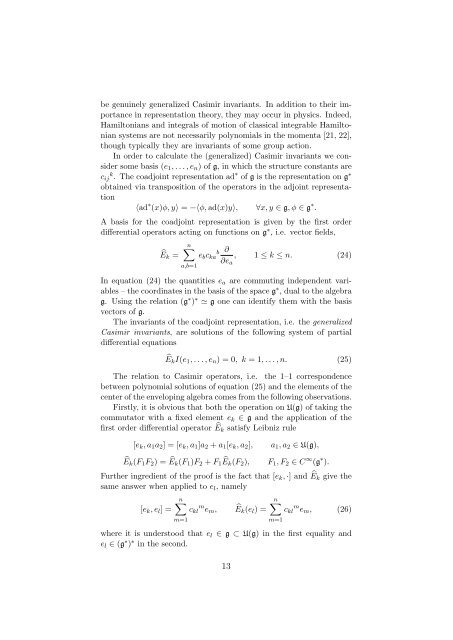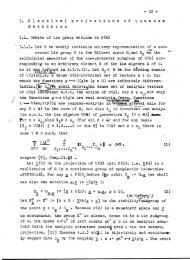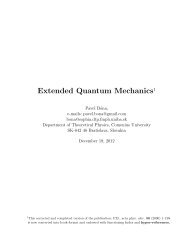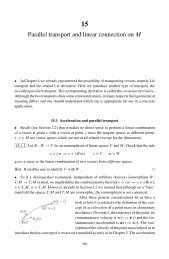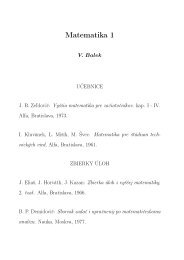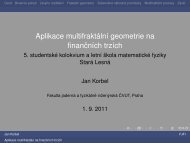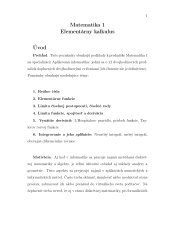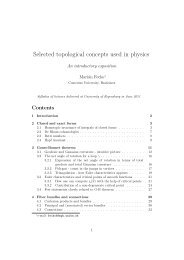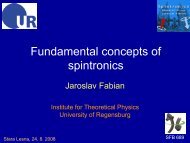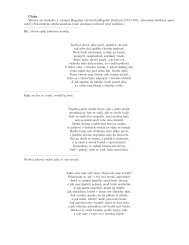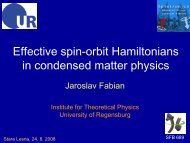Representations of Lie algebras, Casimir operators and their ...
Representations of Lie algebras, Casimir operators and their ...
Representations of Lie algebras, Casimir operators and their ...
You also want an ePaper? Increase the reach of your titles
YUMPU automatically turns print PDFs into web optimized ePapers that Google loves.
e genuinely generalized <strong>Casimir</strong> invariants. In addition to <strong>their</strong> importancein representation theory, they may occur in physics. Indeed,Hamiltonians <strong>and</strong> integrals <strong>of</strong> motion <strong>of</strong> classical integrable Hamiltoniansystems are not necessarily polynomials in the momenta [21, 22],though typically they are invariants <strong>of</strong> some group action.In order to calculate the (generalized) <strong>Casimir</strong> invariants we considersome basis (e 1 , . . . , e n ) <strong>of</strong> g, in which the structure constants arec ij k . The coadjoint representation ad ∗ <strong>of</strong> g is the representation on g ∗obtained via transposition <strong>of</strong> the <strong>operators</strong> in the adjoint representation〈ad ∗ (x)φ, y〉 = −〈φ, ad(x)y〉, ∀x, y ∈ g, φ ∈ g ∗ .A basis for the coadjoint representation is given by the first orderdifferential <strong>operators</strong> acting on functions on g ∗ , i.e. vector fields,Ê k =n∑a,b=1be b c ∂ka , 1 ≤ k ≤ n. (24)∂e aIn equation (24) the quantities e a are commuting independent variables– the coordinates in the basis <strong>of</strong> the space g ∗ , dual to the algebrag. Using the relation (g ∗ ) ∗ ≃ g one can identify them with the basisvectors <strong>of</strong> g.The invariants <strong>of</strong> the coadjoint representation, i.e. the generalized<strong>Casimir</strong> invariants, are solutions <strong>of</strong> the following system <strong>of</strong> partialdifferential equationsÊ k I(e 1 , . . . , e n ) = 0, k = 1, . . . , n. (25)The relation to <strong>Casimir</strong> <strong>operators</strong>, i.e. the 1–1 correspondencebetween polynomial solutions <strong>of</strong> equation (25) <strong>and</strong> the elements <strong>of</strong> thecenter <strong>of</strong> the enveloping algebra comes from the following observations.Firstly, it is obvious that both the operation on U(g) <strong>of</strong> taking thecommutator with a fixed element e k ∈ g <strong>and</strong> the application <strong>of</strong> thefirst order differential operator Êk satisfy Leibniz rule[e k , a 1 a 2 ] = [e k , a 1 ]a 2 + a 1 [e k , a 2 ], a 1 , a 2 ∈ U(g),Ê k (F 1 F 2 ) = Êk(F 1 )F 2 + F 1 Ê k (F 2 ), F 1 , F 2 ∈ C ∞ (g ∗ ).Further ingredient <strong>of</strong> the pro<strong>of</strong> is the fact that [e k , ·] <strong>and</strong> Êk give thesame answer when applied to e l , namely[e k , e l ] =n∑c m kl e m , Ê k (e l ) =m=1n∑c m kl e m , (26)m=1where it is understood that e l ∈ g ⊂ U(g) in the first equality <strong>and</strong>e l ∈ (g ∗ ) ∗ in the second.13


